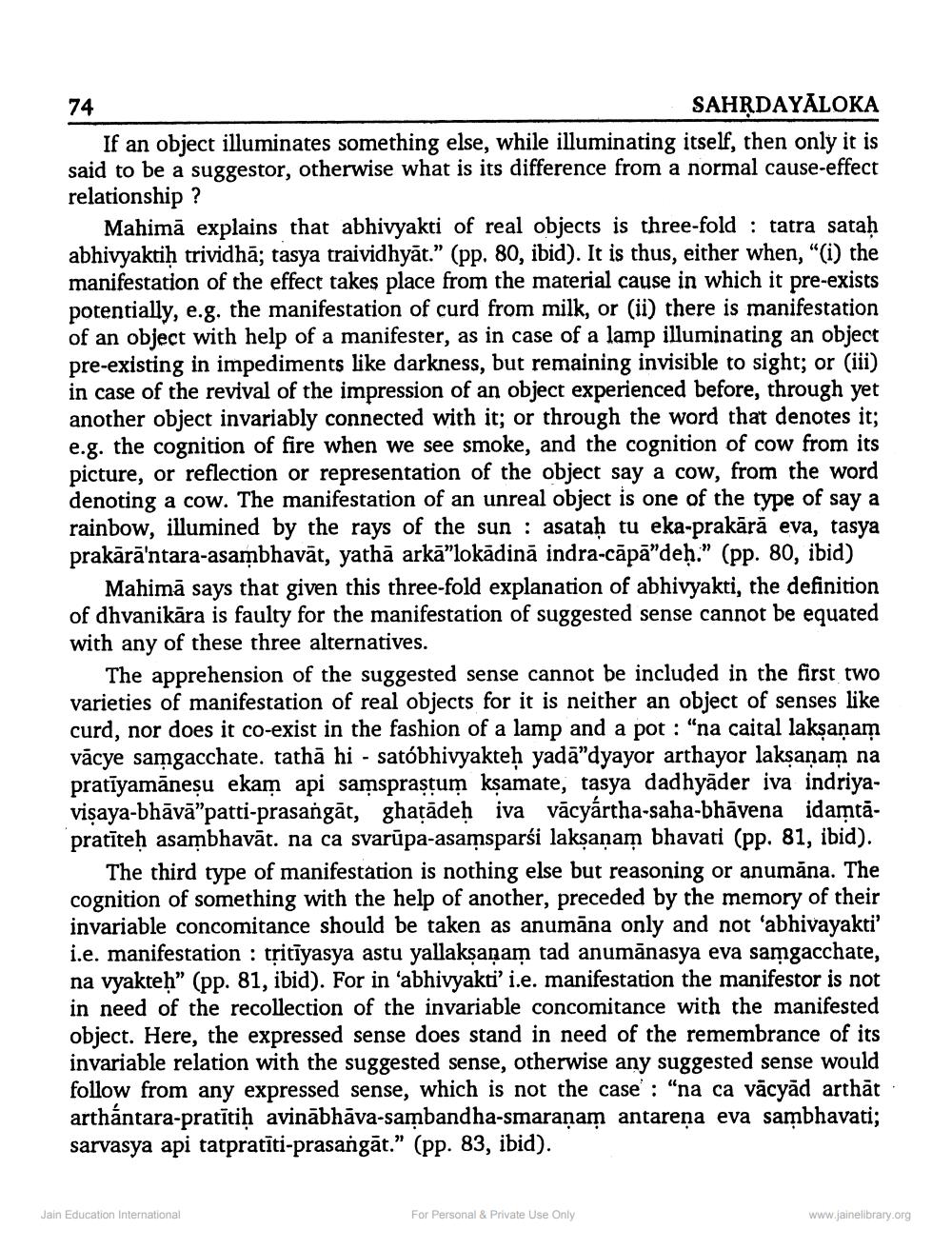________________
74
SAHRDAYALOKA If an object illuminates something else, while illuminating itself, then only it is said to be a suggestor, otherwise what is its difference from a normal cause-effect relationship?
Mahimā explains that abhivyakti of real objects is three-fold : tatra satah abhivyaktih trividhā; tasya traividhyāt.” (pp. 80, ibid). It is thus, either when, “(i) the manifestation of the effect takes place from the material cause in which it pre-exists potentially, e.g, the manifestation of curd from milk, or (ii) there is manifestation of an object with help of a manifester, as in case of a lamp illuminating an object pre-existing in impediments like darkness, but remaining invisible to sight; or (iii) in case of the revival of the impression of an object experienced before, through yet another object invariably connected with it; or through the word that denotes it; e.g. the cognition of fire when we see smoke, and the cognition of cow from its picture, or reflection or representation of the object say a cow, from the word denoting a cow. The manifestation of an unreal object is one of the type of say a rainbow, illumined by the rays of the sun : asatah tu eka-prakārā eva, tasya prakārā'ntara-asambhavāt, yathā arkā”lokādinā indra-cāpā"deh.” (pp. 80, ibid)
Mahimā says that given this three-fold explanation of abhivyakti, the definition of dhvanikāra is faulty for the manifestation of suggested sense cannot be equated with any of these three alternatives.
The apprehension of the suggested sense cannot be included in the first two varieties of manifestation of real objects for it is neither an object of senses like curd, nor does it co-exist in the fashion of a lamp and a pot : “na caital laksanam vācye samgacchate. tathā hi - satóbhivyakteh yada"dyayor arthayor laksanam na pratiyamăneșu ekam api samspraştum ksamate, tasya dadhyader iva indriyavisaya-bhāvā”patti-prasangāt, ghatādeh iva vācyártha-saha-bhāvena idamtā. pratīteh asambhavāt. na ca svarūpa-asamsparsi laksanam bhavati (pp. 81, ibid).
The third type of manifestation is nothing else but reasoning or anumăna. The cognition of something with the help of another, preceded by the memory of their invariable concomitance should be taken as anumāna only and not 'abhivayakti' i.e. manifestation : tsitiyasya astu yallakṣaṇam tad anumānasya eva samgacchate, na vyakteh" (pp. 81, ibid). For in ‘abhivyakti' i.e. manifestation the manifestor is not in need of the recollection of the invariable concomitance with the manifested object. Here, the expressed sense does stand in need of the remembrance of its invariable relation with the suggested sense, otherwise any suggested sense would follow from any expressed sense, which is not the case' : "na ca vācyād arthāt arthántara-pratitih avinābhāva-sambandha-smaranam antarena eva sambhavati; sarvasya api tatpratīti-prasangāt.” (pp. 83, ibid).
Jain Education International
For Personal & Private Use Only
www.jainelibrary.org




